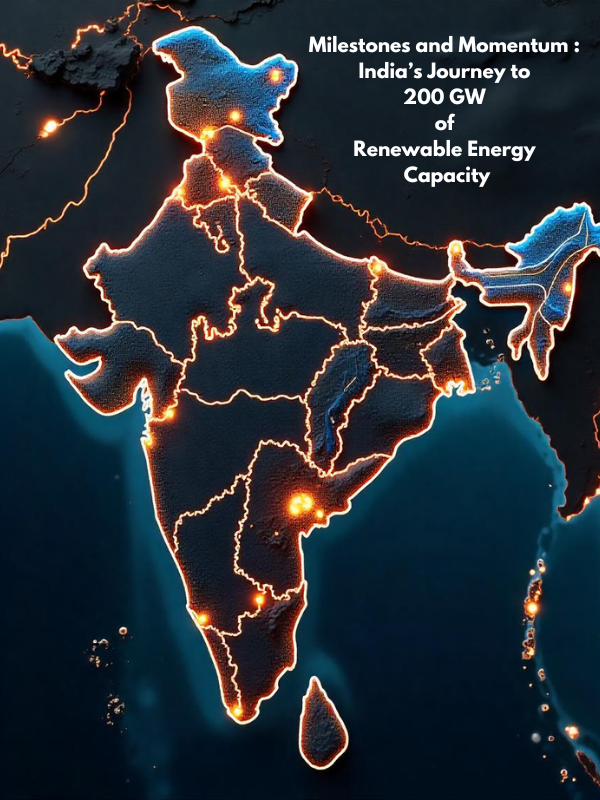On October 10, the world turned its focus to a report released by the Central Electricity Authority, which marked a significant milestone: India has officially exceeded 200 GW of installed renewable energy capacity. This achievement is more than just a statistic; it symbolizes the nation’s ambitious journey toward a greener, more sustainable future. At Safearth, We are honored to have played a role in this journey by adding 405 MW through various advanced solar solutions.
As of September 30, 2024, India’s total electricity generation capacity has reached 452 GW. The thermal sector, which includes coal, lignite, gas, and diesel, contributes 243 GW. Coal remains the primary source of energy in India, with 211 GW generation capacity. Out of India’s total power generation capacity , 201 GW comes from renewable sources, including large hydropower. The data shows that renewable sources make up 46% of India’s total power generation capacity. When nuclear energy is also factored in, this percentage exceeds 50%, underscoring India’s commitment to expanding its clean energy portfolio and advancing toward its ambitious net-zero targets.
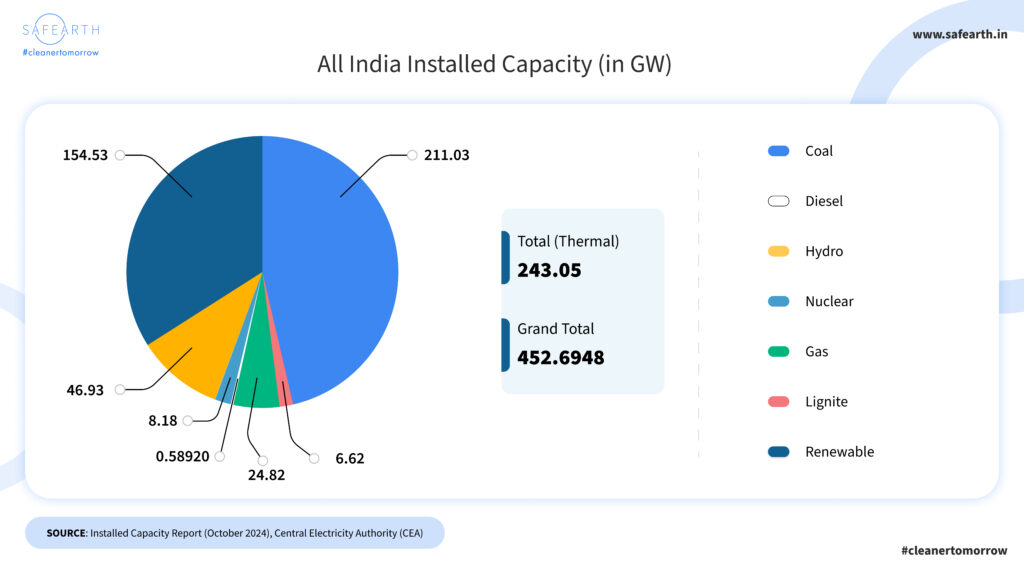
Diverse Energy Mix Powers India’s Renewable Growth
India’s achievement of 201.4 GW of renewable energy has been made possible through a diverse mix of solar, wind, small and large hydropower, as well as biomass and waste-to-energy initiatives.
Solar power emerges as the dominant contributor, accounting for nearly 45% of this capacity. Wind and large hydropower are close contenders for second and third place, with installed capacities of approximately 47.3 GW and 46.9 GW, respectively. Biomass, small hydro, and waste-to-energy follow in contributing to the remaining capacity. While not directly included in the 201 GW figure, the report highlights that nuclear energy contributes 8 GW nationwide. This reinforces India’s broader goal of achieving 100 GW of nuclear capacity by 2047 as part of its transition to net-zero.
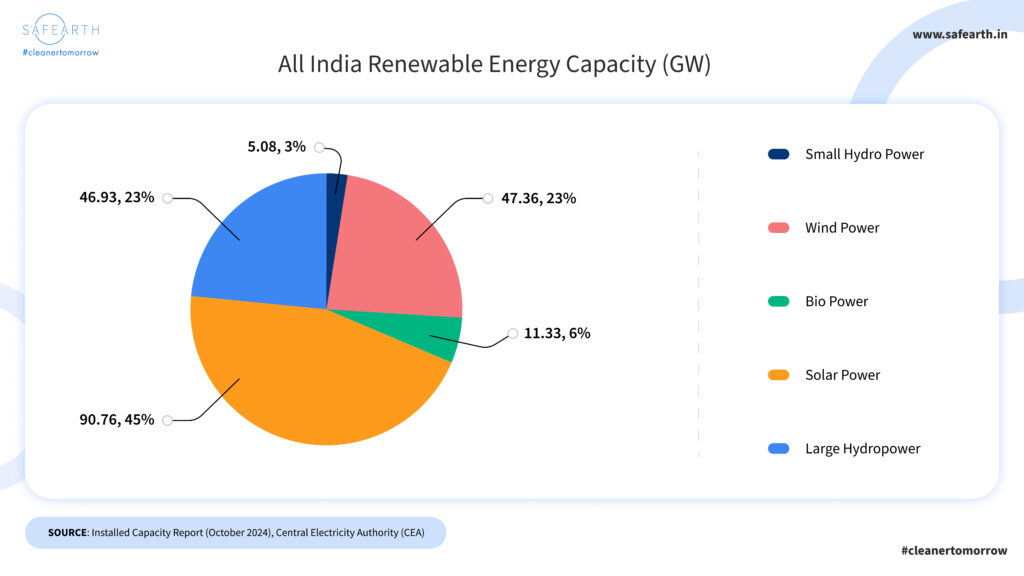
Note: Bio power includes both biomass and waste-to-energy capacity additions.
State Wise Overview of Total Energy Generation
In India, Gujarat leads the way in power generation with a total capacity of 54.5 GW. This achievement is the result of a balanced mix of thermal and renewable energy sources, with 17 GW generated from coal and 15 GW from solar. Notably, Gujarat’s contribution to the solar revolution from the beginning has set a benchmark for other states to follow.Following Gujarat, Maharashtra ranks second with a total power generation of 49.4 GW, where thermal energy accounts for approximately 60% of this capacity.
Rajasthan holds the third position, contributing 46.2 GW, of which 68% comes from renewable sources including hydro, showcasing its dedication to sustainable energy.Tamil Nadu and Karnataka occupy the fourth and fifth spots, generating 41 GW and 33.5 GW, respectively. Both states have significantly invested in renewable energy, contributing to their impressive power generation capabilities.
Rajasthan: Leading the Way as the Cleanest State in the Country
In the renewable energy generation statistics, the rankings of these states undergo slight adjustments.Rajasthan takes the lead with an impressive 31.5 GW of renewable capacity, of which a staggering 24 GW is sourced solely from solar energy.This success is primarily due to the state’s numerous utility-scale solar projects, which have established Rajasthan as the current leader in India’s solar revolution.
Gujarat follows closely with a total renewable capacity of 29.5 GW. Like Rajasthan, its accomplishments are driven by both utility-scale projects and substantial rooftop installations. In fact, Gujarat stands out as the national leader in rooftop solar, contributing an impressive 4.3 GW of installed capacity to its overall renewable energy efforts.
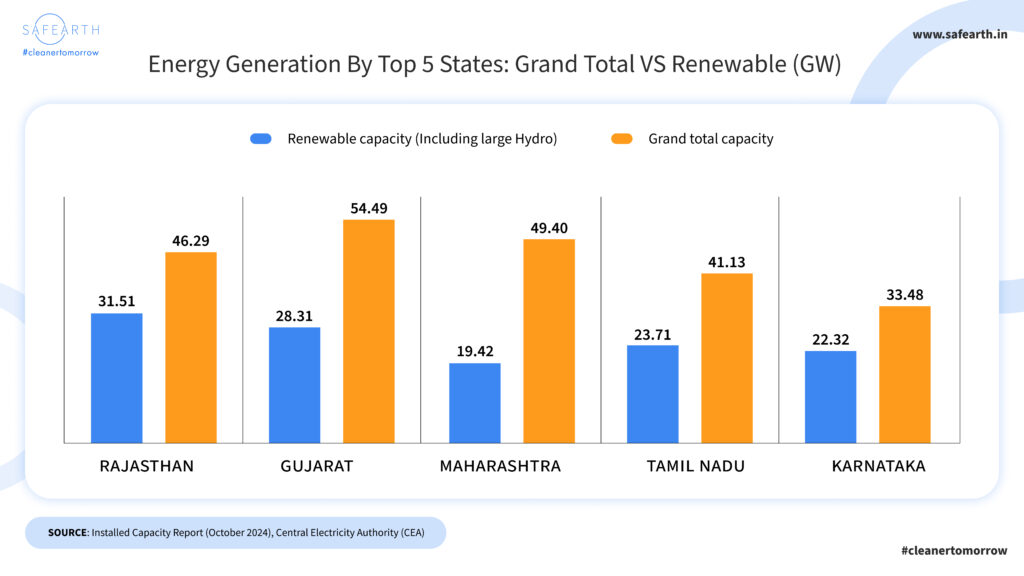
Tamil Nadu ranks third with 23.6 GW of renewable energy capacity. Unlike other leading states, Tamil Nadu’s renewable landscape is dominated by wind energy, which accounts for 11 GW, positioning it as a significant player in the wind sector.Finally, Karnataka occupies the fourth position with a total renewable capacity of 22.4 GW. The state has a well-balanced energy mix, with around 40% from solar, 30% from wind, and 10% from biomass, highlighting its diverse approach to generating renewable energy
SafEarth has emerged as a prominent player in India’s renewable energy sector, with a strong presence across the country. Rajasthan, top leader in renewable energy generation, is where we have made one of our largest contributions, with approximately 100 MW of solar projects across various projects. We are also in the process of developing a 70 MW (DC) solar park in Bikaner, designed to meet the energy needs of corporate clients. This project will employ innovative models like third-party sales and captive consumption, utilizing shared infrastructure to optimize efficiency.
Karnataka follows closely, with our strong presence of around 60 MW of installations. Maharashtra and Tamil Nadu hold the next positions with 50 MW and 40 MW of capacity, respectively. SafEarth operates across India and has already assisted over 200 businesses in reducing their carbon emissions by 600,000 tons, marking a significant step toward a greener future.
India’s Renewable Energy Set to Outpace Overall Capacity Growth
.A recent report by CRISIL highlights India’s continued momentum in the renewable energy space, stating that “India’s renewable energy capacity is expected to grow at twice the rate of the country’s overall energy capacity growth”.According to data from the MNRE, the country’s renewable energy capacity, excluding large hydro, was a mere 3.5 GW in 2014. However, by this fiscal year alone, India had already added 10.9 GW of new capacity, demonstrating an accelerated push towards renewable solutions.The report further projects that by fiscal 2030, the renewable capacity (excluding large hydro) will reach 360-370 GW, with an impressive compound annual growth rate (CAGR) of 16.5-17%.
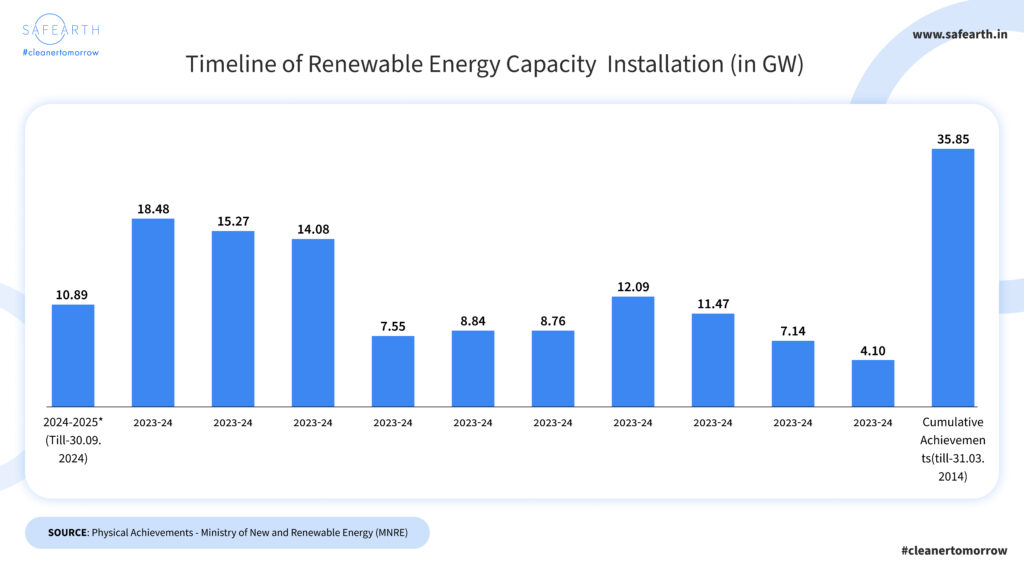
Note: The renewable energy capacity figures exclude large hydroelectric power.
The Dominance of Solar Energy: A Catalyst for India’s Energy Transition
Over the past decade, solar energy has emerged as a frontrunner in India’s efforts to combat climate change, showcasing an astonishing growth rate of over 3,000%. As of September 30, 2024, the country has installed an impressive total of 90.76 GW of solar capacity, with nearly 8.95 GW added in just this year alone.In comparison, wind energy has also seen substantial growth over the same period, with a rate of 125%. However, the stark difference between the two growth rates highlights the pivotal role solar energy plays in India’s energy transition.
This trend is reflected globally, as solar energy continues to lead with 1.9 TW installed by 2023. The ease of installation and maintenance, combined with the affordability of solar electricity, has made it a preferred choice for countries around the world. Many nations are embracing solar power not only to reduce their carbon footprints but also to enhance energy security and meet growing electricity demands.
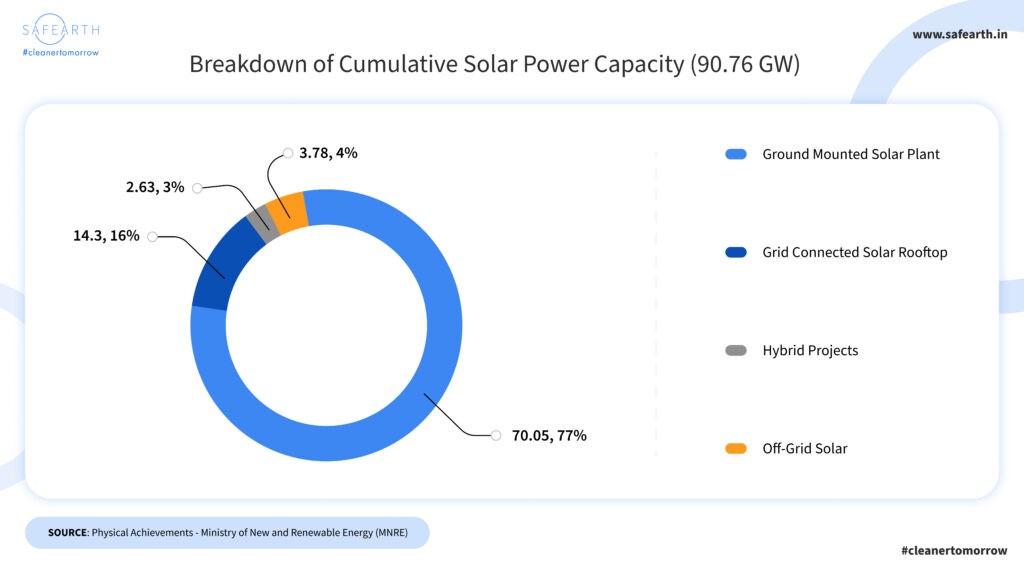
The Solar Divide: Evaluating Utility and Rooftop Installations in India
India’s solar energy mix comprises various types of installations: Ground-Mounted Solar Plants, Grid-Connected Solar Rooftops, Hybrid Projects (with a solar component), and Off-Grid Solar systems. Ground-mounted projects dominate the landscape, accounting for 77% of the total 90.76 GW installed as of September 30, 2024. The majority of the country’s solar capacity is driven by large utility-scale solar parks. India is home to several ultra-mega solar parks, each with a capacity of over 1 GW, including two of the largest solar parks commissioned in the world to date. These solar parks continue to attract global capital and engage some of the most renowned domestic and international renewable energy developers.
On the other hand, rooftop solar has progressed more slowly. With a cumulative capacity of 14.6 GW, rooftop solar has not met expectations. When India’s ambitious goal of reaching 100 GW of solar power was announced, 40 GW was anticipated to come from rooftop installations. Although the overall target of 100 GW is within reach ahead of the 2026 deadline, the rooftop segment has achieved less than half of its target..
The shortfall in rooftop solar deployment can be attributed to several factors. While utility-scale solar projects benefit from economies of scale that reduce installation costs, rooftop systems tend to have higher costs per unit for energy. Financing for large-scale projects is also more accessible, as these projects often receive government support or secure long-term power purchase agreements. In contrast, residential rooftop systems face challenges with loan access and creditworthiness. Additionally, the regulatory process complicates matters further, as rooftop solar projects often experience delays in grid integration and obtaining approvals from local utilities.
SafEarth has built a strong presence in both the utility and rooftop solar sectors. Over the past five years, the company has established a solid track record in utility scale open-access solar projects, completing more than 200 MW of capacity across 13 sites throughout India. These projects not only contribute significantly to clean energy generation but also drive job creation
We take particular pride in our work within the rooftop solar segment, where more than 75% of our projects are dedicated. Despite the challenges that the rooftop solar sector faces in India, we remain optimistic and committed to unlocking its potential.. Our team continues to work diligently, leveraging innovative approaches to encourage the adoption of rooftop solar solutions across various sectors.
C&I Sector: Opportunities and Obstacles
In India’s rooftop solar sector, commercial and industrial (C&I) customers lead the way, accounting for 75% of installations, while the residential sector makes up only 25%. With over 300 million households and abundant sunshine, there is significant potential for solar energy growth in this sector. High electricity prices for C&I consumers make rooftop solar an attractive option, whereas subsidized grid tariffs for residential users reduce their motivation to switch to solar.
However, government initiatives like the “Surya Ghar Muft Bijli Yojana” launched in 2024 are changing this trend. This program offers a subsidy of ₹78,000 for each residential solar system, with additional state support possible, increasing interest among homeowners. As a result, the payback period for residential solar is now just 4 to 5 years, encouraging more people to make the switch.
The implementation of the Green Open Access Rules, 2022, in some states has shifted focus from rooftop solar to open access (OA) projects among the C & I customers. State regulators have prioritized OA approvals, which has slowed the growth of rooftop installations.
The micro, small, and medium enterprises (MSMEs) sector in the C&I division offers a promising opportunity for rooftop solar adoption, with an estimated potential of 15 GW. To unlock the full potential of MSMEs for rooftop solar, government support similar to what is provided for residential solar is essential.Industry experts are increasingly exploring the concept of aggregating demand from C&I customers. This approach could facilitate the issuance of larger tenders, ultimately lowering energy bills.
Currently,C&I customers benefit from a 40% tax depreciation incentive, which is their only significant advantage for adopting rooftop solar.Low-cost financing remains a crucial barrier for the C&I segment. Therefore, providing concessional credit lines through multilateral development banks will be vital. Additionally, refinancing options and blended finance strategies could effectively reduce capital costs in the C&I renewable energy market, making it easier for businesses to transition to solar energy.
The active participation of C&I customers is crucial for India’s journey toward achieving its net-zero goals. With the commercial and industrial sectors consuming nearly 50% of the country’s total electricity, their transition to clean energy is a pivotal step. SafEarth recognized this early on, and making affordable, clean energy accessible to them has become a primary goal of our company. By empowering C&I customers to embrace renewable energy, we are driving a significant shift towards sustainability while contributing to national targets and supporting economic growth.
Safearth envisions promoting solar energy in the C&I sectors through three core domains:
- Software Stack: Safearth’s platform streamlines solar projects for C&I customers, encompassing everything from the initial site assessment to engineering, procurement, and installation. This ensures a seamless project lifecycle, maximizing efficiency and effectiveness.
- Procurement: Safearth’s marketplace consolidates procurement requirements for C&I projects, allowing smaller suppliers to benefit from economies of scale. This approach reduces costs and enhances the feasibility of solar solutions for businesses, making it easier for them to transition to sustainable energy.
- Financing: Through strategic financing partnerships, Safearth addresses the working capital challenges faced by C&I clients, facilitating faster and scalable deployment of solar energy solutions. This support empowers businesses to adopt solar technology, paving the way for a more sustainable future.
Conclusion
Although renewable energy additions seem to be on an accelerated trajectory, the future does not look particularly promising. An IRENA report based on UAE consensus, published in October 2024, indicates that while global renewable energy capacity has increased eightfold over the past 20 years and costs have fallen by more than 80 percent, the current trends “aren’t moving fast enough.” To keep the 1.5°C goal within reach, tripling renewable power capacity and doubling energy efficiency by 2030 are essential. However, current national plans and targets of most countries are projected to deliver only half of the necessary annual growth in renewable power capacity. To achieve the tripling goal, global annual renewable power capacity additions must average 1,044 GW per year until 2030. Meeting this target will require an investment of USD 1.5 trillion annually between 2024 and 2030.These figures underscore the tremendous effort required from all countries to ensure a sustainable future.India, already excelling in the renewable sector, is well-positioned to seize this opportunity and must prepare for extensive commitments in the coming years. All stakeholders—governments, businesses, and civil society—must intensify their efforts to make significant progress toward these critical objectives.
At Safearth, we are driven by bold ambitions and a clear vision to take on the climate battle head-on. As India powers forward in its renewable energy revolution, we are committed to rising with it, determined to make a lasting impact in this critical fight for our planet’s future

